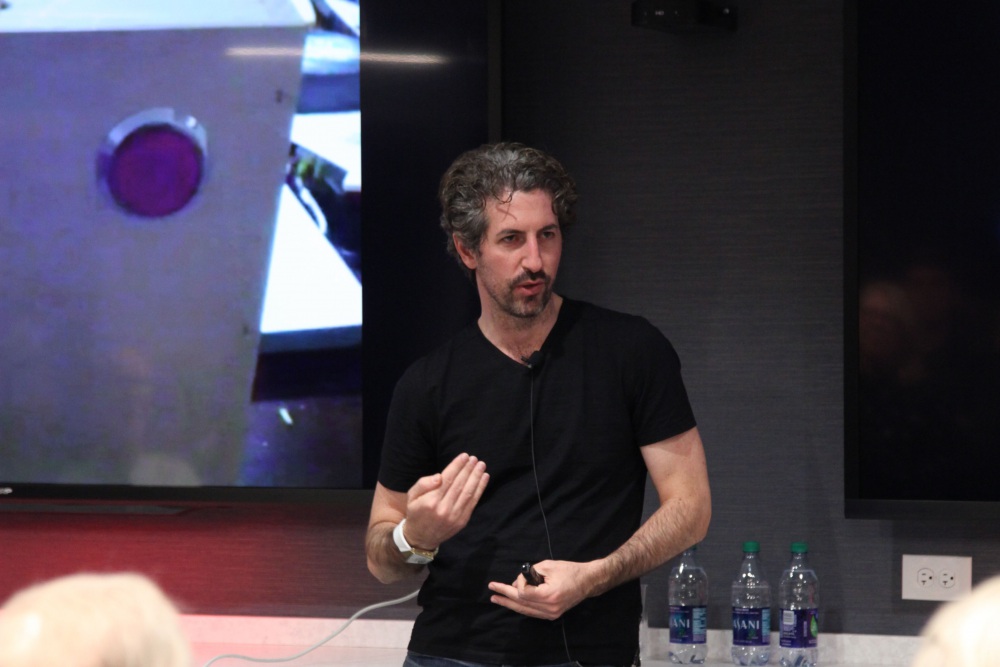
Atomic Pulse
NTI Seminar: Neuroscientist Moran Cerf on How the Brain Processes Risk

The potential consequences of nuclear
weapons use or climate change, to name two of the world’s leading threats, are undeniably
terrifying – so why are these concerns not on the forefront of everyone’s minds?
Dr. Moran Cerf, professor of neuroscience and business at Northwestern
University’s Kellogg School of Management, headlined the December installment
of NTI’s Seminar Series to discuss how the brain processes risk, how risk is
studied, and what influences risk perception – all of which have interesting
implications for the field of catastrophic risk reduction.
Conscious vs. Unconscious
Thought
There is no single
part of the brain that identifies risk. A person’s perception of fear is
controlled in the amygdala and love in the hypothalamus, but there is no “risk
center” in the brain, making it difficult to study how people process and
respond to risk. As a result, neuroscientists approach the study of risk
through dual lenses: conscious thought and unconscious thought.
Dr. Cerf opened
his discussion at NTI by describing the difference between conscious thought
and unconscious thought as a man riding an elephant. The man might be
explaining to the elephant where he’d like to go and why, which represents
conscious thought. More than likely, however, the elephant is carrying the man
wherever it wants, representing unconscious thought, and the man is merely explaining the elephant’s actions as though they were his choice. By studying a person’s conscious
thoughts along with their unconscious behaviors, neuroscientists can learn more
about a person’s true perception of risk when handling certain situations,
choices, or perceived dangers.
How is risk studied?
To study
conscious thought when perceiving risk, neuroscientists do something
surprisingly simple: they ask a lot of questions. They ask people about scenarios
where they’d have to make difficult choices, often about their finances or personal
needs, and they use the answers to identify a person’s risk tolerance. However,
because these answers are prone to cognitive error, they don’t give a full, accurate
picture of a person’s true perception of risk.
Unconscious
thought is then studied by detecting unperceivable reactions in the body that display
how a person is reacting to certain stimulus before a person cognitively knows
of their reaction. Cerf gave several examples:
- Eyes: The brain and the eyes work together to process
information, but the eyes track slightly faster than the time it takes for the
brain to process visual input. Researchers study eye tracking to learn what a
person finds important in a field of vision instinctively, before a person has
processed the visual enough to explain. - Facial Muscles: You cannot control all the muscles in
your face, which is why it easy to discern a fake laugh from a real laugh, as
the muscles around the eyes will spontaneously engage with real laughter in a
way that cannot consciously be mimicked. Researchers will use sensors to detect
engagement of smaller facial muscles to detect responses to risky stimulus. - Skin: The conductivity of a person’s skin spikes in response to
certain risks in a way that humans can’t perceive. By using sensors attached to
the skin, researchers can identify when a person feels something is risky by
detecting a change in their skin’s conductivity. - Brain: When hearing or responding to specific situations,
corresponding neurons fire in the brain. Researchers can therefore identify which
neurons fire for certain decision-making situations, and can predict a person’s
choice before the person is cognitively aware of the decision they’re about to
make.
What can be learned from
this information?
In a way,
having this information is a bit like reading someone’s mind. Researchers can
use it to predict behavior – from whether a person will choose to turn left or
right while driving a car, to whether he or she would rather bungee jump than
gamble their life savings. They can even use the information to alter a
person’s behavior. Some studies have shown that stimulating certain neurons
while a person sleeps can cause addicted smokers to feel a strong aversion to
smoking for a short period of time. Most importantly, they can use the information
to build a profile for a person’s “risk tolerance” or the situations and
decisions that a person perceives to be on the spectrum of risk.
What determines a person’s
“risk tolerance?” What does this mean for perception of catastrophic risk?
Humans have
evolved to innately fear certain scenarios because those scenarios have proven
deadly or dangerous in the experiences of their ancestors. For example, many people are innately afraid
of spiders, likely because certain types of spiders have harmed their ancestors’
peers, teaching our ancestors that avoiding spiders is beneficial. While those
risks are developed through centuries of evolution, newer risks to the human
race are not as strongly perceived. Dr. Cerf described that a person will never
be as afraid of something in theory as they will be after experiencing it
first-hand.
This makes the
perception of catastrophic risk quite tricky. Very few people have first-hand
experience of living through a nuclear attack or the effects of global
pandemic, and therefore can only theorize about the devastating consequences. The
good news is that while innate risks (i.e. spiders) cannot be perceived as any
riskier, as they are already at the extreme of a person’s risk tolerance, people
can increase their perception of risks that are not evolutionary inherent.
How can people’s perception
of catastrophic risks be influenced so they recognize them as more serious?
- Virtual Reality: Dr. Cerf explained that the use of
virtual reality has been very effective in helping people overcome their
aversion to certain risky situations, such as heights or small spaces, and he theorized
that the technology might be able to be used to induce the opposite reaction.
If virtual reality were to create an experience that very closely mimicked the
consequences of a catastrophic risk, a person’s perception of said risk could
be heightened. This would be the closest a person could come to actually
experiencing real fear in a catastrophic risk situation without experiencing
true harm, and would theoretically effectively maximize a person’s risk
perception. - Identify a Victim: A slightly less traumatizing, but still
effective, tactic would be asking people to visualize a victim in response to a
theoretical catastrophic event. By identifying a subject who would experience
the devastation of such an event, a person can empathize with them or imagine the
fear themselves. Identifying a victim in the third person or the first person both
showed increased neuron firing when perceiving risk, though a first-person
victim narrative was more effective.
Beyond perception of such
issues, the study of risk has created some unique implications for the field of
catastrophic risk reduction. In a Q+A session with the audience, Dr. Cerf
shared some unexpected outcomes of the intersection of catastrophic risks and neuroscience:
- The
world’s nuclear codes are some of the most secure pieces of information in
existence, for good reason. However, even if a password is composed of
incredibly long character sequences and changed every day, someone would always
know the password. To err is human,
so having the password in someone’s conscious thought is a security
vulnerability. The question posed to neuroscientists was this: is there a way
for a password to be unknown to the conscious mind, but known to the
unconscious mind? The answer? The video game Guitar Hero. By using a long
pattern of falling key commands and a keyboard, subjects who practiced the
sequence were able to complete the entire sequence without mistakes while those
who were given the task without preparation could not accurately complete the
exercise. The person’s subconscious mind was able to recall the movements, but
the conscious mind was not able to recall the key strokes. - Experiencing
risk increases a person’s chances of falling in love. A study in New Zealand
reported that people asked to cross a perilous bridge, and then stopped by a
person of the opposite sex to chat in the midst of doing so, experienced a
feeling of “falling in love” with the person who had stopped them. Experiencing
risk and falling in love have very similar physical reactions such as increased
heart rate and quickened breathing, and the brain interprets the fear of risk
as the heightened emotion of love.
So,
the next time you’re on a first date, maybe bring up NTI’s work in catastrophic
risk reduction. It might just win them over.
Stay Informed
Sign up for our newsletter to get the latest on nuclear and biological threats.
